Uncanny X-Men: Part 7, Issues #54-58 – Havok and Neal Adams
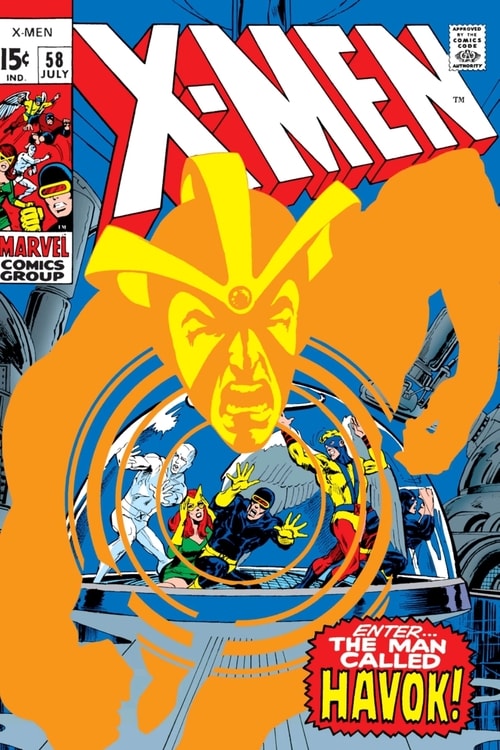
I was super-tempted to pause my blogging about my X-Men reread to complain about my reread of another classic, but I opted for the high road and am glad I did, because this was a fun post to think through. And, for those of you still with me, we’re almost at the end of the original X-Men! So pull up a chair for the 7th installment of my reread of the X-Men.
In this post, I want to look at issues #54-58 (March, 1969 – July, 1969), a run that contains two major Silver Age milestones. The first is the introduction of Alex Summer, the mutant brother of Scott Summers. Alex will eventually join the X-Men as their 7th member. The second is equally exciting – the beginning of Neal Adams’ brief but spectacular run. The team-up of Roy Thomas and Neal Adams marks the beginning of the zenith of the original team, outshining the Kirby-Lee issues and sitting comfortably at the same table as many of the great Claremont-Byrne stories.
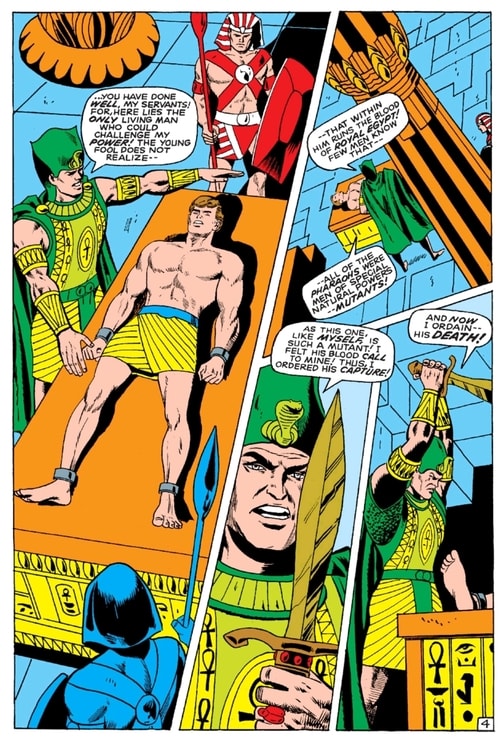
Arnold Drake wrote and Don Heck and Vince Coletta drew issue #54, which starts with a bang in media res with Cyclops waking up in a museum at the night guards’ gunpoint, accused of murder. The story flashes back to Cyclops and the X-Men attending the graduation of Alex Summers, Scott’s hitherto unmentioned brother.
After the ceremony, Alex is attacked by some goons from The Ten Commandments, so that he can be the subject of a weird Egyptian sacrifice. The X-Men of course try to rescue and confusion and superheroics ensue.
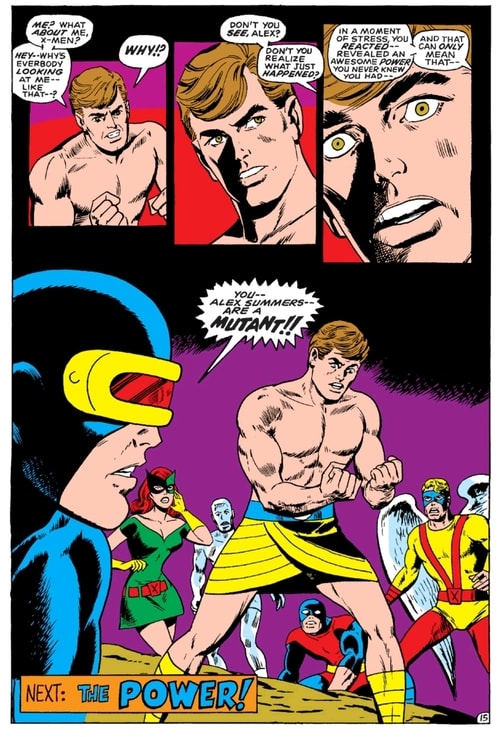
Interestingly, Don Heck is experimenting with layouts, like diagonal gutters, diamond-shaped and triangular panels and some distinctly Steranko-esque poses, especially for Marvel Girl. I can’t say I’m a fan of the new layouts (examples below) because I don’t think they’re particularly successful.
Layout, along with the image composition and negative space (and the lettering) is supposed to guide the reader’s eye around the page. However, Heck’s composition is so crowded that the lettering has to focus on just fitting, and the panel gutters don’t seem to be related to the postures and movement lines, as they should if pages are well laid out.
Issue #55 finally brings back Roy Thomas as writer, with Heck on pencils, but Werner Roth on inks. There’s more typical Silver Age fighty-fighty and Alex and Scott are captives, taken to Egypt, where in the desert, they defeat the Living Pharaoh, partly with the help of the generically-depicted mutant powers of Alex Summers – basically some utterly phoned-in wavy lines.
Issues #54 and #55 are not inspired or executed. The Living Pharaoh is a clunky villain concept and Alex’ introduction to the X-Men is jarring and only partly cooked. If not for the place Alex Summers will have in X-Men history going forward, and the X-Men origin back-up stories, I wouldn’t recommend remembering these two issues. But this is the introduction of Alex Summers and these issues set up the launch of a spectacular run.
Issue #56 introduces Neal Adams. Adams had been drawing professionally since about 1960, but his work was mostly commercial advertising art and from 1962 to 1966, the Ben Casey daily newspaper strip, which is like the Holy Grail for comic artists of that time. Nonetheless, Adams was not satisfied with the creative freedom nor the corporate cut of his income and he left. This is a theme that runs throughout his career, and yet it left him with a problem in his pocketbook.
He found comic work with Warren’s horror magazines. He managed to get short gigs and covers at DC throughout 1967 and 1968, but was turned down for Batman. His larger comics break came with his work on Deadman in Strange Adventures and his photorealistic art style began to make its mark on comics. The X-Men was his first Marvel work and one of two contributions to the company (along with The Kree-Skrull War in The Avengers) before he finally was picked up for Detective Comics.
Neal Adams’ opening splash page for his Marvel work is striking, and the hits keep on coming, page after page. The emotion in the faces are like very little else in the Silver Age and the layouts are creative and artistic, with great panels, hyper-accurate perspective (as opposed to Kirby, Steranko and Barry Smith’s impressionistic perspectives). Adams is also not shy about having some figures and action standing over and beyond gutters and panels. Thomas’ over-dialoguing cuts some of the effect – the lettering can’t lead the eye around the page if word balloons fill every available bit of negative space.
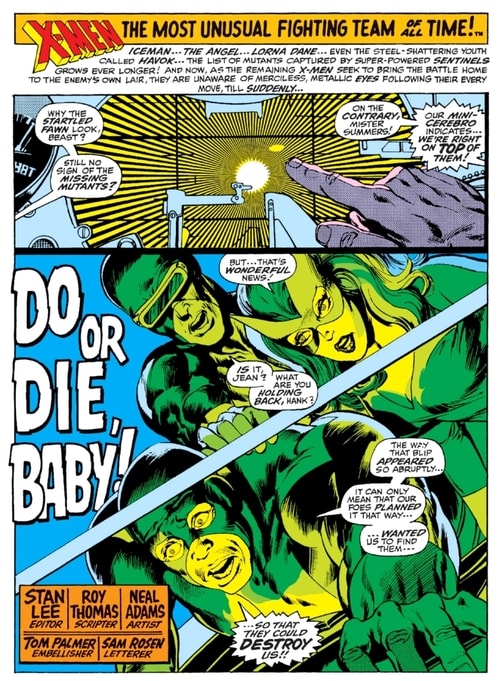
I hope the image below is not too hard to see. It’s extra wide because Adam’s used the whole two pages to lay out the art. It is a great example of how the panel gutters (black in this case, instead of the normal white) frame the action and guide the eye and reinforce the kinetics of the images, in ways that Heck’s layouts above just didn’t do. Same with the page that follows.
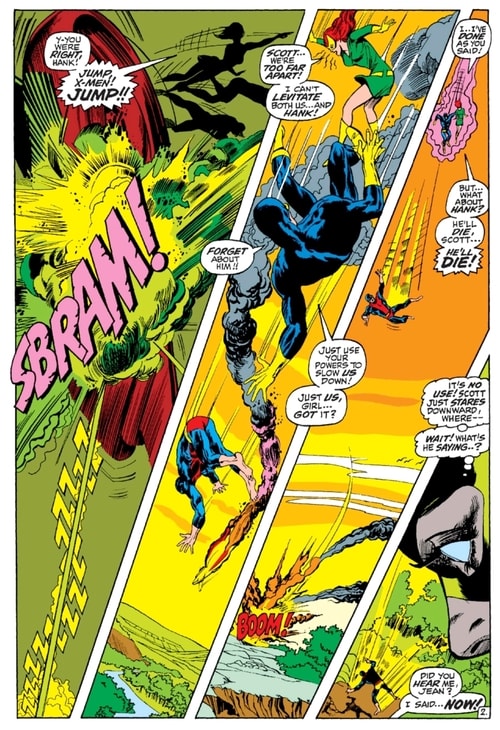
The plot clarifies a lot – the Living Pharaoh locks Alex Summers in a chamber that blocks him from absorbing cosmic radiation, so that the Living Pharaoh gets all of it, transforming into the Living Monolith. I mean, the science works, but Thomas has made sense of the villain and his relationship to the hero in a narratively effective way – Alex Summers and the Living Pharaoh have to share power.
But something goes wrong and Alex, locked up, still not knowing how to use his powers, loses control and discharges, destroying the chamber and the whole three thousand year old temple he was in, depowering the Living Monolith.
Issue #57, by Roy Thomas, Neal Adams and Tom Palmer, opens big, with Sentinels coming after Lorna Dane (still not called Polaris), while Egyptian police come after the X-Men in the desert. While the X-Men deal with them Alex, in fear of his powers, runs and hides, only to also be captured by Sentinels.
Bobby finds out that Lorna is no longer at his apartment, and there’s every sign of forcible capture, and worries himself sick, leading him and Beast back to the States to help her. It’s an exciting issue, with powerful art and solid story ideas, if executed in the caption- and word ballon-heavy Silver Age style of writing. When he was younger, my son had a hard time with these issues, explaining “nobody talks like that!”
In issue #58, the Sentinels capture Iceman, and in captivity, he finds an unconscious Lorna and Alex dressed in the suit that we’ll know as his distinctive costume for the next fifteen years. I think he only changes it in the late 80s when everyone needed to show their mullets. This is a beautiful character design contribution by Adams, as is the visual feel of Havok’s plasma blasts, which are some of the coolest in comics.
Thomas sets up the foundation of a nice love triangle between Alex, Lorna and Bobby that will get worse over the next few blog posts, and also writes an interestingly devious villain in Trask, at least for now. The Sentinels capture a bunch of other folks, basically a who’s who of mutants we’ve seen throughout the series, until someone shows that Trask is himself unknowingly a mutant, which costs him control of his giant robot fascists.
This is as far as I’m going to go today. I didn’t meant to end on a cliffhanger, but the break points I picked make sense because I wanted to keep the Sauron-Savage Land story together for the next post. I hope you’re still having fun. Next post (#8) will conclude the original X-Men series at issue #66, and I’ll leave the topic of blog post #9 a secret for now. See you in two weeks!
If you want to catch up on any of my other posts about the X-Men, they’re below:
- Part 0: A Fresh Look at X-Men Continuity: Ed Piskor’s Grand Design
- Part I: Introducing The Strangest Super-Team of All: Uncanny X-Men #1 (Nov 1963) to #20 (May 1966)
- Part II: Early Guest Appearances (1964-65), Uncanny X-Men #21-23 (1966), and X-Men: First Class Volume I (2006)
- Part III: X-Men: First Class, Volume II (2007) and First Class Finals
- Part IV: Uncanny X-Men #24-39: The Middle Years of the Original Team
- Part V: Uncanny X-Men #40-48: Death and Separation
- Part VI: Uncanny X-Men #49-53: Reunion and Family and Steranko
- Part VII: Uncanny X-Men #54-58 — Havok and Neal Adams
- Part VIII: Uncanny X-Men #59-66: The Savage Land and the End of the Silver Age X-Men
- Part IX: Filling in the Corners of the Original X-Men with Savage Hulk #1-4
- Part X: John Byrne’s The Hidden Years #1-4
- Part XI: Storm, the FF and Phoenix in John Byrne’s The Hidden Years
- Part XII: X-Men Guest Appearances in 1971-1972 and Hank gets Furry!
- Part XIII: Englehart’s Bronze Age Monster Horror – The Beast
- Part XIV: 1973 and 1974 – Magneto, the Hulk, Banshee and post-Watergate Captain America
- Part XV: 1974 and 1975 – The Last Tales of the Original X-Men
- Part XVI: Enter Wein, Claremont and Cockrum in 1975
- Part XVII: 1976 — Sentinels in Space and the Rise of Phoenix
- Part XVIII: Juggernaut and Magneto — For the Very First Time
- Part XIX: Phoenix, Firelord and the Imperial Guard
- Part XX: Iron Fist, Blame Canada and Some Strike-Outs
- Part XXI: Epic Magneto Triumph and more X-Men Death!
- Part XXII: 1978 — The Savage Land, Japan and Psionic Throwback Thursday!
- Part XXIII: 1979 — Chaos in Canada with Alpha Flight!
- Part XXIV: Arcade, Murderworld and their First King-Sized Annual
- Part XXV: The Proteus Saga and My First Comics!
Derek Künsken writes science fiction in Gatineau, Québec. His first novel, The Quantum Magician, a space opera heist, was a finalist for the Locus, Aurora and Chinese Nebula awards. Its sequel, The Quantum Garden is on sale now. His third novel, The House of Styx, has just been announced jointly by Solaris Books and Analog Science Fiction and Fact who will be publishing it in hardcover and serial form, respectively. In fact, the first installment in Analog is on newsstands now with the amazing cover below!
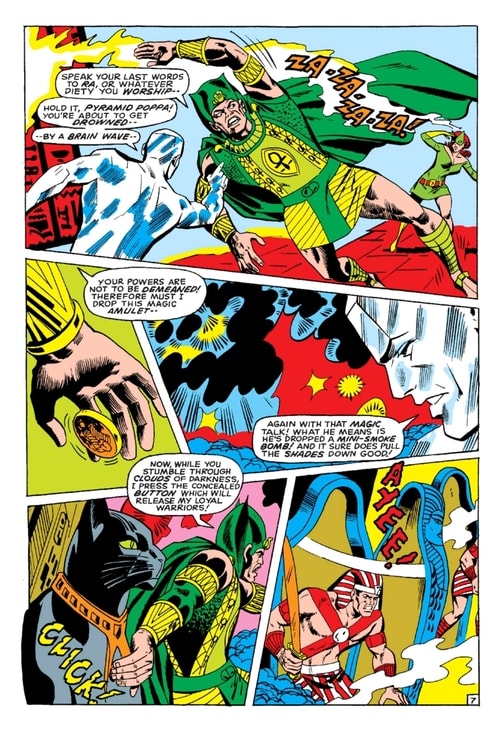
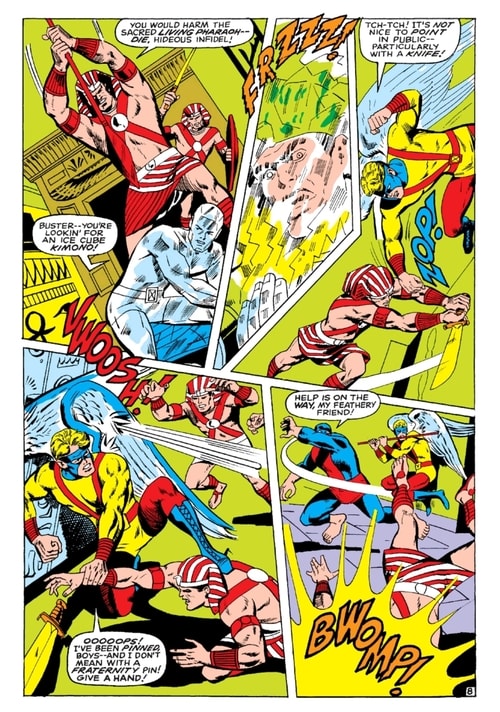
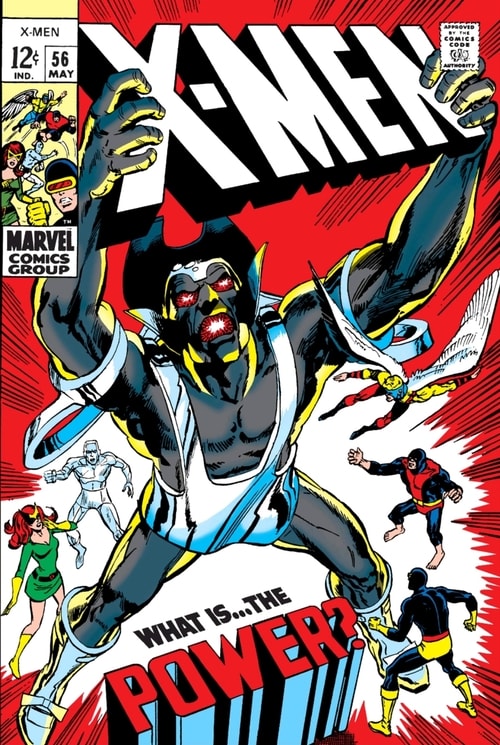
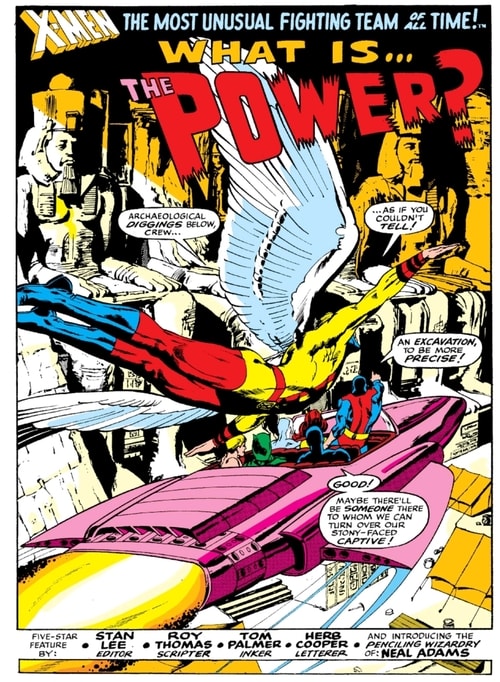
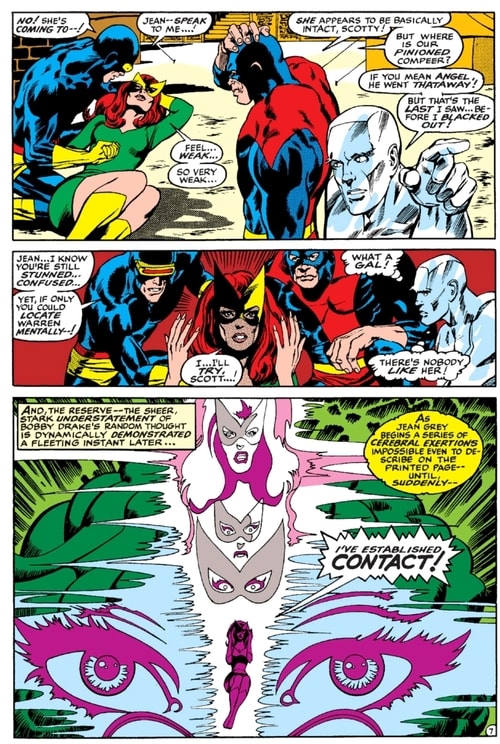
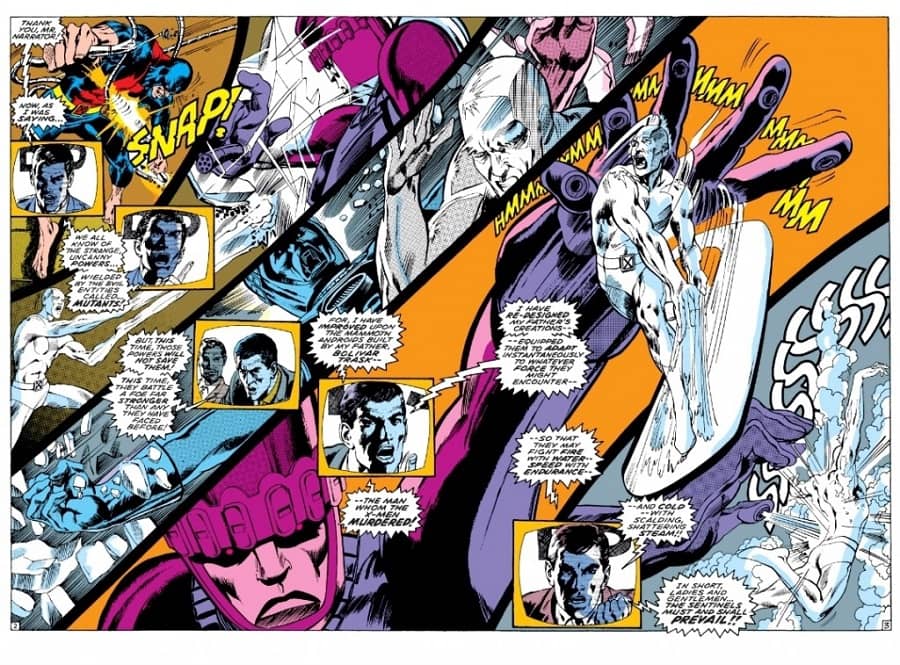
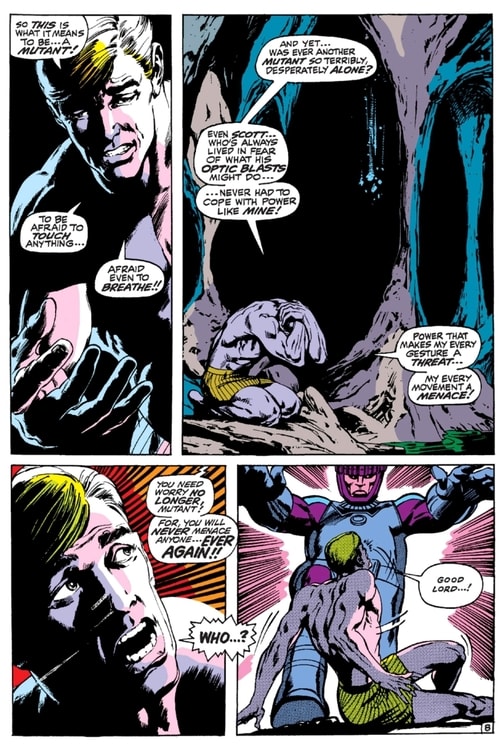
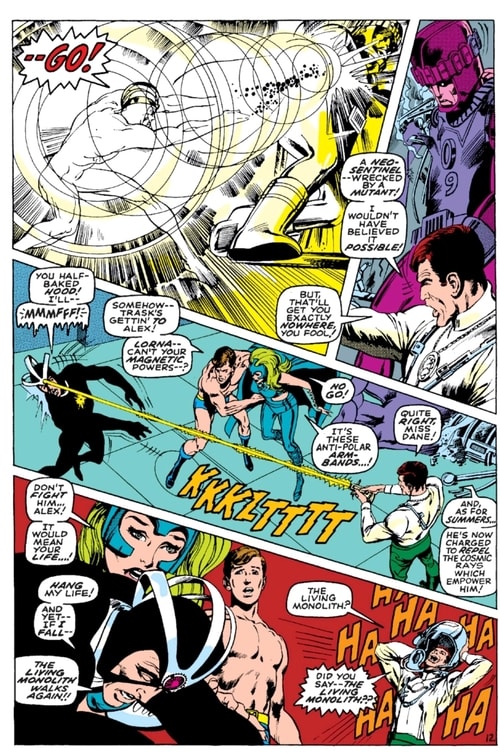

I mentioned before that I read 90% of the Mavel silver age between 1961 and 1971. Doing that really helped me see just how much of an impact Steranko and Adams made. There is nothing else like what they were doing.
I would say Steranko was more creative when it comes to art and panel design, but Adams work here on X-Men has a much better narrative flow. I have a hard time following the story in Steranko’s Captain America. Whereas here the panel design serves to move the story forward.
That two page spread with the TV anchor describing what the Sentinals are capable of when they are doing it to Hank and Bobby is pure genius and years ahead of its time.
I forget who wa seeing interviewed but I remember someone saying that these issues really increased sales on the title. But with the way the industry worked at the time Marvel didn’t get the sales numbers until months later and by that time Neal had moved on.
> I mentioned before that I read 90% of the Mavel silver age between 1961 and 1971.
Glenn,
Holy cats! That’s a pretty big reading project. Did you do that recently, or as they were coming out?
My peak comic reading years were the mid-80s, when I tried everything Marvel and DC put out. But I was far more selective, and ended up following only about 15% of their output regularly. Now, First Comics, Eclipse, Pacific Comics, and the other independents… I read 80% of their output for years.
I’m only 30. So I did not read them coming out. I did it off and on between 2014 and 2019. I had to take breaks because the 60s dialogue can get pretty boring.
I did read them as they came out, that is, from mid-1967 on. X-Men was a drab little title when I started reading Marvel, though it was the favorite of my best friend. But by the time of the Adams issues, it provided relief for me. By that time, Kirby and Lee were wasting space in Thor (which had been my entry into Marvel) with pointless large or even full-page panels that took Kirby probably all of five minutes to draw, dragging out stories into multi-part pseudo-epics; you could say that we’d had grandeur, now we had the grandiose. Goodwin and Tuska ensured that Iron Man, never a compelling series anyway, was drab. And so on. To be sure, we hadn’t hit the bottom yet! The covers were still free of hideous word balloons and were not being dashed off by Gil Kane (who once had been kind of an enjoyable artists). The Avengers wasn’t yet handed over to Sal Buscema for the art chores. But the covers were getting more cluttered, certainly:
http://www.mikesamazingworld.com/mikes/features/newsstand.php?type=calendar&month=5&year=1969&publisher=marvel&sort=alpha&checklist=null
I’m sure its different reading it all at once and with modern eyes. But I thought Goodwin’s arc was the only good Iron Man series until Michelinie and Layton.
I like Gerry Conway’s Spider-Man but he took over Iron Man after Goodwin and it is rough.
Good assessment Derek. Just read (for the first time) #s 56 & 57 last night, collected in Giant-Size X-Men #2. Reading these old books, I can’t help but wonder at the sheer excess verbiage cluttering up these beautiful panels. What were they thinking? That readers were idiots? That Thomas’ clunky dialogue was preferable to Adams’ gorgeous art? And what a shock it must have been for readers to go from Heck to Adams!
Thanks Shawn! Wow. How was Giant-Sized X-Men #2? Even on the old paper it must have been beautiful. I do feel that that era’s over-writing is definitely a drawback for any readers after the bronze age (say, 1986). If you like Silver Age X-Men in the book-clubbing sense, I do recommend two podcasts:
Greymalkin Podcast: https://podcasts.apple.com/us/podcast/graymalkin-lane-the-podcast/id1568987168 (I love it and have even been on a couple of times). They cover the whole silver age of X-Men from a fun, light perspective, reveling in the silliness as well as the great stuff.
Marvel By the Month Podcast: https://marvelbythemonth.com/. They are what they say they are – they read one month’s worth of marvel comics for each episode and they started with November, 1961 (FF #1). They gave some discussion time for Neal Adams’ work on both X-Men and Avengers.